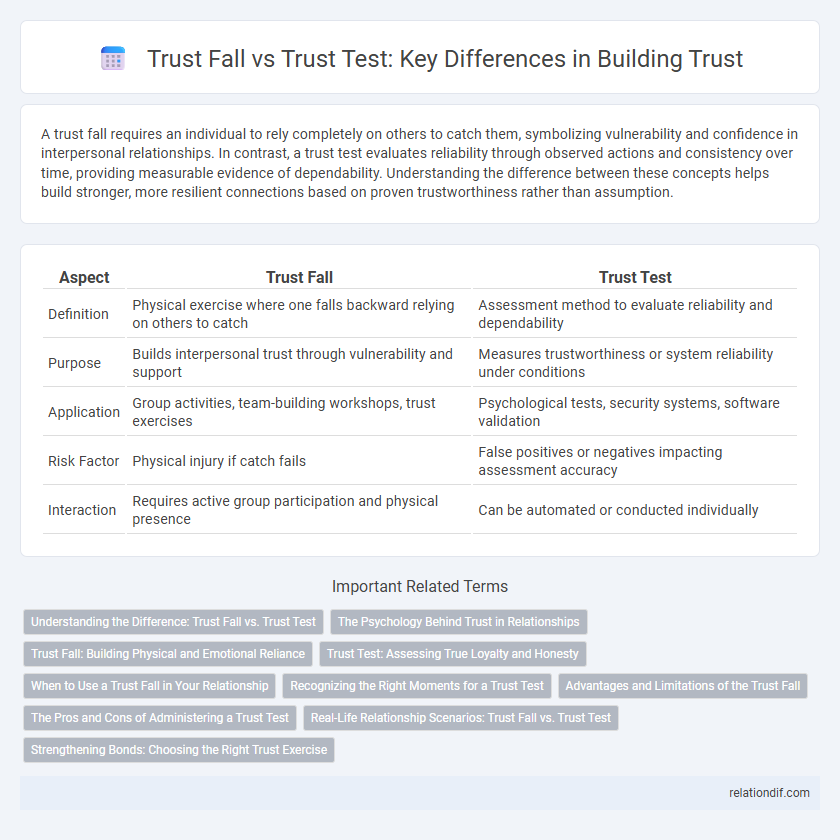A trust fall requires an individual to rely completely on others to catch them, symbolizing vulnerability and confidence in interpersonal relationships. In contrast, a trust test evaluates reliability through observed actions and consistency over time, providing measurable evidence of dependability. Understanding the difference between these concepts helps build stronger, more resilient connections based on proven trustworthiness rather than assumption.
Table of Comparison
| Aspect | Trust Fall | Trust Test |
|---|---|---|
| Definition | Physical exercise where one falls backward relying on others to catch | Assessment method to evaluate reliability and dependability |
| Purpose | Builds interpersonal trust through vulnerability and support | Measures trustworthiness or system reliability under conditions |
| Application | Group activities, team-building workshops, trust exercises | Psychological tests, security systems, software validation |
| Risk Factor | Physical injury if catch fails | False positives or negatives impacting assessment accuracy |
| Interaction | Requires active group participation and physical presence | Can be automated or conducted individually |
Understanding the Difference: Trust Fall vs. Trust Test
Trust fall exercises involve physically relying on others to catch you, emphasizing vulnerability and immediate cooperation, while trust tests assess reliability and honesty through scenarios that measure consistency over time. The trust fall builds emotional bonding by creating a moment of shared risk, whereas trust tests evaluate a person's character and dependability through observed behaviors. Understanding this difference helps organizations and teams choose appropriate methods to strengthen trust based on their specific goals and context.
The Psychology Behind Trust in Relationships
Trust falls rely on physical vulnerability and the expectation of support, activating neurobiological responses linked to oxytocin release that reinforce emotional bonds. Trust tests evaluate consistency and reliability over time, engaging cognitive processes related to risk assessment and social cognition. Both methods highlight the psychological interplay between perceived safety and emotional investment in relationship dynamics.
Trust Fall: Building Physical and Emotional Reliance
Trust fall exercises foster physical safety and emotional reliance by encouraging individuals to surrender control and depend on teammates for support. This practice enhances group cohesion, strengthens interpersonal bonds, and cultivates an environment of mutual confidence. Consistent participation in trust falls cultivates resilience and deepens trust through shared vulnerability and accountability.
Trust Test: Assessing True Loyalty and Honesty
Trust tests reveal genuine loyalty and honesty by evaluating consistent behavior under pressure, distinguishing authentic relationships from superficial ones. Unlike trust falls, which rely on physical dependence and immediate reactions, trust tests assess long-term reliability through observed actions and responses. Accurate trust assessments utilize scenario-based evaluations, behavioral analysis, and feedback to ensure deep understanding of a person's trustworthiness.
When to Use a Trust Fall in Your Relationship
Trust falls are most effective in relationships where physical presence and vulnerability foster deeper emotional connections, making them ideal for solidifying newly formed trust or repairing minor breaches of confidence. This activity demonstrates tangible reliance and encourages partners to openly express acceptance and support, which is crucial in early or transitional relationship phases. For long-standing relationships or when trust issues stem from deeper emotional wounds, alternative trust tests focusing on communication and consistency may yield more meaningful insights.
Recognizing the Right Moments for a Trust Test
Trust fall exercises build confidence through physical reliance, but recognizing the right moments for a trust test requires emotional awareness and situational judgment. Effective trust tests evaluate consistency, integrity, and vulnerability in real interactions rather than staged scenarios. Timing trust tests appropriately fosters genuine connection and deepens relational bonds by revealing authentic trustworthiness.
Advantages and Limitations of the Trust Fall
The trust fall exercise builds physical and emotional trust by encouraging participants to rely on others for support, fostering team cohesion and increased interpersonal confidence. Its advantages include promoting vulnerability and immediate feedback on trustworthiness, but it may also induce anxiety or discomfort for individuals uncomfortable with physical dependence or lacking prior rapport. Limitations involve potential physical risk and the assumption of mutual trust, which can unintentionally highlight mistrust if safety is not assured or participants feel coerced.
The Pros and Cons of Administering a Trust Test
Administering a trust test offers clear advantages by providing measurable insights into team reliability and individual accountability, often revealing hidden trust issues that can be addressed proactively. However, trust tests may also create discomfort or skepticism among participants, potentially leading to resistance or superficial responses that undermine genuine relationship building. Balancing transparency with sensitivity is crucial to maximize the benefits of trust tests while minimizing their drawbacks.
Real-Life Relationship Scenarios: Trust Fall vs. Trust Test
Trust fall exercises simulate vulnerability and encourage physical reliance, fostering immediate emotional connection in real-life relationship scenarios. Trust tests, involving consistent behaviors over time, better reflect genuine trust by assessing reliability, honesty, and commitment in everyday interactions. Evaluating trust through ongoing actions ultimately strengthens the foundation of authentic relationships beyond momentary exercises.
Strengthening Bonds: Choosing the Right Trust Exercise
Trust fall exercises build confidence by requiring participants to physically rely on others, enhancing group cohesion through vulnerability and support. Trust tests, often involving problem-solving tasks, evaluate reliability and communication, fostering mutual understanding and collaboration. Selecting the right trust exercise depends on the group's goals, whether deepening emotional bonds or assessing team dynamics.
Trust fall vs trust test Infographic

 relationdif.com
relationdif.com